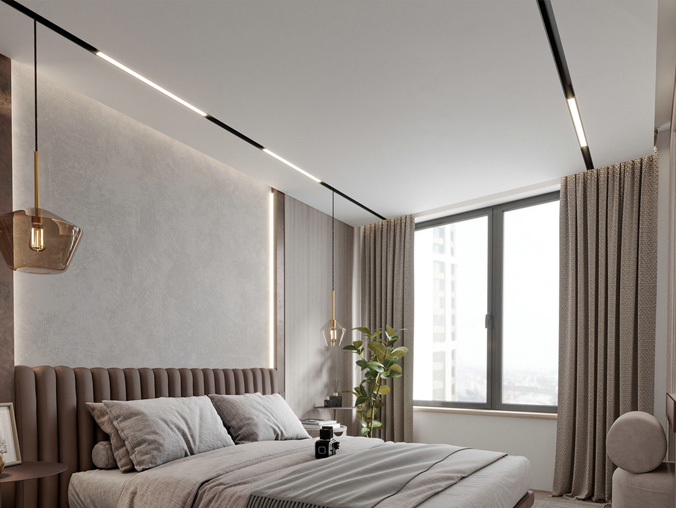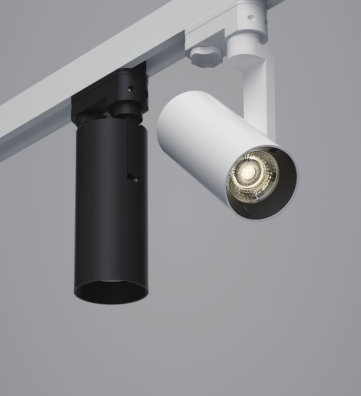

Whether recessed lights (embedded lighting fixtures) need a transformer depends on their rated voltage: low-voltage recessed lights (12V/24V) require an external transformer to convert household AC 110V/220V to low-voltage DC, while high-voltage recessed lights (110V/220V) integrate a built-in driver (replacing the need for a separate transformer) and can be directly connected to household circuits. Premium recessed lights like IMIGY’s high-voltage models not only eliminate transformer-related installation hassle but also pair seamlessly with recessed light track systems (Combo Track Lights, Uranus Track Light) and other recessed lighting components (recessed light fixture, additional recessed lights) for unified, simplified wiring. Below is a breakdown of transformer needs, product advantages, and practical tips.
1. Transformer Requirement by Recessed Lights Voltage Type
a. Low-Voltage Recessed Lights (Need Transformer)
Application scenario: Small decorative spaces (e.g., bedroom coves, display cabinets) or areas requiring safe low-voltage operation (child rooms). These recessed lights (e.g., 12V 5W mini models) rely on an external transformer—install the transformer in a ceiling cavity or junction box (away from heat sources) to avoid overheating.
Limitation: The transformer’s power must match the total wattage of recessed lights (e.g., a 100W transformer for 8×10W lights). Using an undersized transformer causes frequent shutdowns.
b. High-Voltage Recessed Lights (No Transformer Needed)
Application scenario: Most residential (living rooms, kitchens) and commercial spaces. High-voltage recessed lights (110V/220V, e.g., IMIGY’s 15W–20W detachable models) integrate a built-in smart driver with rectification and voltage stabilization functions. They connect directly to household circuits like regular bulbs—no transformer reservation required.
Advantage: Saves ceiling space (no transformer cavity needed) and reduces installation complexity, ideal for post-renovation upgrades.
2. IMIGY Products’ Transformer Advantages & Synergy
a. High-Voltage Recessed Lights & Combo Track Lights
Living Room Scenario: Use 6 high-voltage recessed lights (18W each, no transformer) as ambient lighting, paired with Combo Track Lights (also high-voltage, built-in driver) for accent lighting. Both connect to the same 220V circuit—no extra transformers, simplifying wiring. For example, the Combo track (2m, max 6 heads) and recessed lights together consume ≤200W, fitting a standard 10A circuit.

Compatibility: The Combo’s track heads use the same high-voltage LED modules as IMIGY’s recessed light fixture—replace modules uniformly without worrying about voltage mismatches.
b. High-Voltage Recessed Lights & Uranus Track Light
Commercial Office Scenario: Link 12 high-voltage recessed lights (20W each) with 2 Uranus Track Light (high-voltage, industrial-grade driver) for task lighting. The Uranus driver’s anti-interference design ensures stable power even when multiple recessed lights are added—no voltage fluctuations (common with low-voltage transformer systems).

Durability: Both the recessed lights (IP40 dustproof) and Uranus track (aluminum alloy) resist wear in high-use commercial spaces (8+ hours/day), avoiding transformer-related failures (e.g., overheating).
3. Practical Tips for Installation & Selection
a. For Low-Voltage Recessed Lights
Transformer Placement: Install the transformer ≥30cm away from recessed light fixture and heat sources (e.g., vents). Use IMIGY’s heat-dissipating transformers (with aluminum casings) for long-term safety.
Wire Gauge: Use 18AWG low-voltage wires (for 12V) to connect lights and the transformer—thinner wires cause voltage drop, dimming the lights.
b. For High-Voltage Recessed Lights
Direct Wiring Check: Ensure household circuits are AC 110V/220V (matching the lights’ rating). IMIGY’s recessed lights have clear “L/N” terminals—no polarity confusion during installation.
Load Calculation: Don’t connect more than 10 high-voltage recessed lights (20W each) to a single 10A circuit—add a new circuit if needed to avoid overload.
4. Mistakes to Avoid
Don’t Mix Voltage Types: Connecting 12V recessed lights directly to 220V (without a transformer) burns the lights; conversely, 220V lights won’t work with a 24V transformer.
Don’t Overload Transformers: A 50W transformer can’t power 10×8W low-voltage recessed lights—always choose a transformer with 20% extra power (e.g., 100W for 80W total load).
Don’t Ignore Built-In Drivers: For high-voltage recessed lights, don’t add an extra transformer—this damages the built-in driver and voids the warranty.
Recessed lights don’t universally need a transformer—high-voltage models (like most IMIGY products) integrate built-in drivers and avoid transformer requirements, while low-voltage models need pre-installed transformers for safety. IMIGY’s high-voltage recessed lights stand out for their simplified installation, compatibility with recessed light track systems (Combo, Uranus), and synergy with other recessed lighting components. Whether you’re renovating a home or commercial space, choosing the right voltage type (and IMIGY’s matching products) eliminates transformer-related troubles. Contact us to get personalized recommendations—we’ll help you select transformer-free or transformer-matched recessed lights based on your space, safety needs, and wiring plan.
It is recommended that you upgrade the latest browser
 Chrome
Chrome Firefox
Firefox Edge
Edge